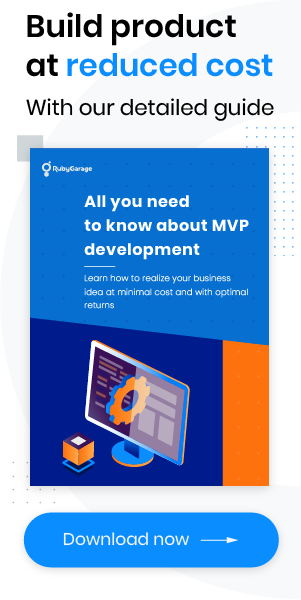-
Product Management
Software Testing
Technology Consulting
-
Multi-Vendor Marketplace
Online StoreCreate an online store with unique design and features at minimal cost using our MarketAge solutionCustom MarketplaceGet a unique, scalable, and cost-effective online marketplace with minimum time to marketTelemedicine SoftwareGet a cost-efficient, HIPAA-compliant telemedicine solution tailored to your facility's requirementsChat AppGet a customizable chat solution to connect users across multiple apps and platformsCustom Booking SystemImprove your business operations and expand to new markets with our appointment booking solutionVideo ConferencingAdjust our video conferencing solution for your business needsFor EnterpriseScale, automate, and improve business processes in your enterprise with our custom software solutionsFor StartupsTurn your startup ideas into viable, value-driven, and commercially successful software solutions -
-
- Case Studies
- Blog
Minimal Marketable Product vs Minimum Loveable Product: Building Upon an MVP
Many of us are familiar with the concept of a Minimum Viable Product (MVP) and its benefits for startups. An MVP helps you deliver your idea to early adopters and gather feedback to make improvements. But did you know that you can create an easily sellable product by building a Minimal Marketable Product (MMP) or a Minimum Loveable Product (MLP)?
Sure, an MVP is perfect to convey your product’s basic features and value to customers and investors. However, it doesn’t display everything your product can be. An MVP is a base upon which you can develop an MMP or an MLP, depending on your goals and resources.
Let’s find out more about these two concepts and what advantages they offer your business.
Minimal Marketable Product
To understand what a minimum marketable product is, we need to look at the origin of this term. Imagine you’ve developed the first version of your MVP. You’ve tested your idea, gathered feedback, and iterated. This cycle can go on for a while until you arrive at a version of your product that potential customers will want to buy.
Think of it this way: an MMP is a combination of several versions of your MVP. As you improve upon each version, an image of the most efficient and compact form of your product is built.

So how exactly is an MMP different from an MVP? The purpose of an MVP is to validate your business idea and determine which problems need to be solved to make users willing to pay money for the product. A minimum marketable product is an MVP that has been repeatedly improved until becoming a sellable product.
Advantages of an MMP
The most uncertain thing about a product under development, and at the same time the most important, is its future. No amount of market research can predict how a product will do after its introduction to users. A minimum marketable product can help minimize losses in case of failure and ease the lack of comprehensible market development foresight
It’s possible to look at MMP as a safety cushion in a number of ways:
- An MMP reduces time to market, which in turn allows you to adjust to user needs and respond accordingly instead of trying to guess what customers want.
- With an MMP, development is cheaper, which increases return on investment in case of success.
- An MMP’s minimalism reduces financial investment, which mitigates risk – less money is lost in case of underperformance.
How can we ensure that our MMP comes with all of these advantages and that its first version is a sellable product? This is where building upon the MVP concept comes into play.
The incorporation of several versions of an MVP in an MMP comes with two key benefits:
- Each MVP refines a final MMP version by acquiring feedback and making room for improvement.
- Customer retention is increased since users are involved in product development and experience improvements firsthand.
Ensuring a smooth transition from MVP to MMP
We’ve already established that building an MMP on the basis of an MVP can lead to more efficient results. Now we want to highlight the essential points for making an effective shift from MVP to MMP that secures your product’s successful release.
- Reliability. Make sure to iron out any potential glitches in your product before its release. Although you can rely on an MVP to catch issues during beta testing, don’t rush to give users access to your MMP too early. It has to be ready for use when it’s introduced to the market.
- Scalability. Assuming your product is useful and effective, you might experience an inflow of users upon release. You need to prepare for accelerating number of signups with a scalable platform that can handle increasing traffic.
- Performance. The speed of your product is essential, even if it isn’t web-based. Any delay in response can lead to the loss of customers. Test your product performance repeatedly and in different ways before its release to market.
At this point, don’t forget that just like an MVP, your minimum marketable product has to solve a problem. Achieving excellence in product performance and durability doesn’t ensure usefulness to prospective customers.
Always remember that the most important criteria upon which your product will be judged are its value and the effectiveness of its solutions.
Minimum Loveable Product
Similar to an MVP and an MMP, a minimum loveable product is the simplest version of a sellable product that can be introduced to the market. But while an MVP is a bare product stripped of non-functional elements, an MLP strives to be a product that can delight customers to the point where they praise it and recommend it to their friends.
The image below demonstrates the difference between an MVP (left) and an MLP (right). As you can see, a viable product is only developed to be functional, while a loveable product incorporates a bit of functionality along with reliability, usability, and emotional design.

How can you know if the product you’re building is loveable? The following characteristics will help you differentiate an MLP from an MVP or MMP:
- Your MLP must be unique, meaning there are no products like it on the market – not necessarily in terms of its function, but in terms of its appeal. This avoids competition and possible analogues, providing customers with a one-of-a-kind experience.
- An MLP is a marathon, not a sprint. Customer love is developed over time. At the testing stage, gaining your audience’s interest will be enough. Once you have their attention, you can gradually build toward receiving their love.
- After introducing your product to the market, people will start contacting you to gather as much information as possible about your MLP: release date, functionality, and so on.
- Prospective customers will display visible emotions when you’re describing the product to them, either positive or negative. Don’t be afraid of negative reactions; the most important thing is to avoid neutrality or disinterest.
- If your product is loveable, you’ll be eager to use it yourself and look forward to adding new features.
Creating an MLP means creating a product the users love instead of tolerate.

Benefits of an MLP
What sets a minimum loveable product apart from a minimum viable or a minimum marketable product? To answer this, we must highlight the advantages of creating an MLP based on your idea:
-
The product becomes customer-oriented. When a team is working on a loveable concept, they’re thinking about users and how to serve them. With viable and marketable products, ideas are business-oriented, leaving customer accountability on the sidelines.
-
User involvement is drastically increased. As the product’s lovability goes up, so does the emotional interaction with customers. Small details that center on the user promote loyalty at every step of the experience.
-
The team is kept on the same course. By eliminating multiple versions of the product, the team focuses on the original strategy, perfecting it along the way. The steady application of customer expectations ensures successful realization of the idea.
-
The product reflects your company’s image. When you’re releasing viable products onto the market, you most likely aim to convey their functionality. With an MLP, you tie the product to your company’s strategy and vision to create an emotional connection with the customer. An MVP is replaceable, but an MLP is an integral part of your organization.
While an MVP is a fast way to get your product to market and an MMP is a sellable product by the time it’s finished, an MLP combines these ideas. It’s fast because of the team’s focus and it’s sellable because it was developed with customers’ needs in mind.
How to shift from an MVP to an MLP
Unlike an MMP, a minimum loveable product doesn’t include several versions of an MVP; it simply improves upon its viable concept. You don’t even need to finish an MVP to start creating an MLP; all you need to do is determine your product’s value and focus on its minimal features to then move on to achieving lovability.
Let’s go over how you can start building your MLP step by step:
- Establish a timeframe
Assemble a group of the most enthusiastic and efficient people in your organization and assign them to the project. Then create a workshop where you can map out your path to success from start to finish. In addition, put constraints on your time and budget.
By setting a deadline for each stage of the project and limiting financial investment, you reduce the scope of work. This means that you and your team will be forced to come up with a fast and cost-effective solution. You’ll also have to adjust to restrictions and learn to build a compact MLP without sacrificing its value.
- Decide on one idea and start working on it
Determine a clear purpose for your product and focus on making a feature that can help you achieve this purpose perfectly. Ideally, the final concept should solve a customer’s problem as well as convey the product’s unique value to users.
The founders of Waze, John Boudreau and Steven Rice, say “Fall in love with the problem, not with the solution,” meaning that as long as you know every aspect of the issue, you’ll be able to come up with a superior solution.
- Add an element of surprise to impress users
Imagine a plain cake: no decorations on top, just some bare layers and frosting here and there. Yes, it serves its purpose, but it leaves the customer underwhelmed. Then take the same cake but heavily frost it and decorate it with fresh fruit. Now it has character and evokes positive emotions.
Apply the same strategy to your product to make it appealing.
- Make an effort to gain a following
Once your product has been released to market, it will start to acquire customers. You need to hook those customers and develop a sense of community associated with your MLP.
You can start by setting up a social media page dedicated to your product. Make it as friendly and engaging as possible, and soon your customers will become active and add unique content that will speak to other prospective users.
Incorporating the concept of lovability into your product helps your idea stand out. Most likely, your target market is filled with viable products that solve the same problem. By adding a little extra thought to the product’s appeal you can disrupt a stable market and catch attention.
Now that you’re familiar with the concepts of a minimal marketable product and a minimum loveable product, you can correlate them with your goals and pick the one most suitable for you. Once you’ve chosen your strategy, the RubyGarage team can assist you with bringing your idea to life.










